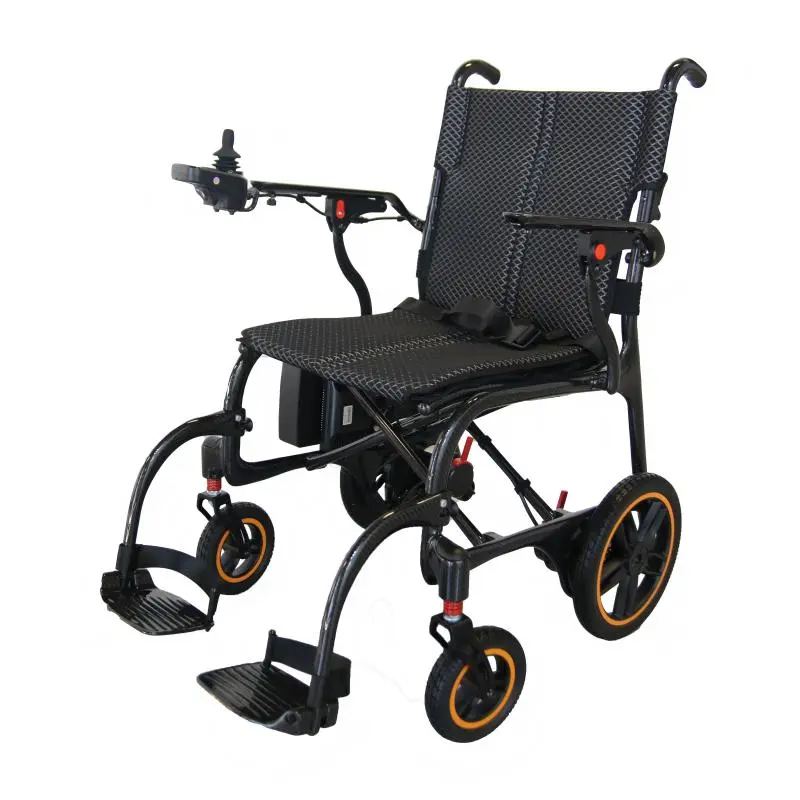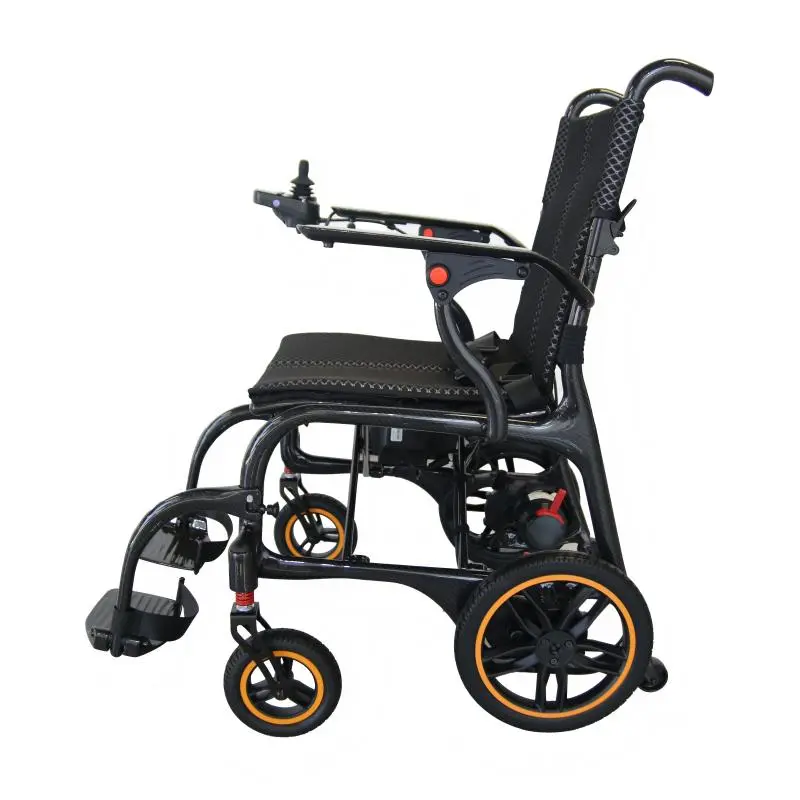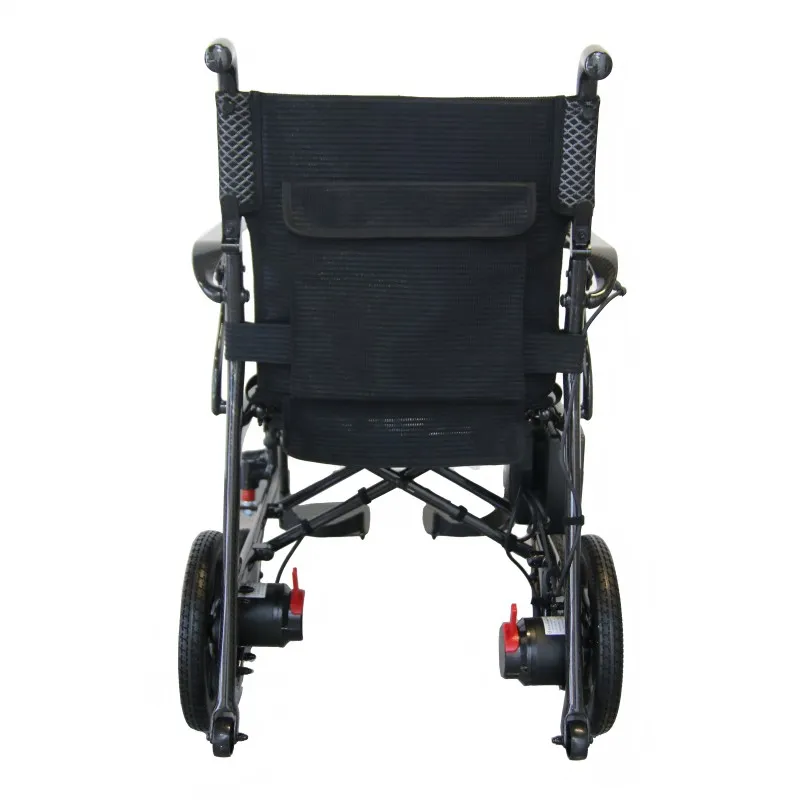"How heavy is a carbon fiber electric wheelchair?" This seemingly simple question actually involves a complex technical chain involving modern materials engineering, overall vehicle design, airline compliance, rehabilitation adaptation, and safety.
This article discusses the reasons why carbon fiber electric wheelchairs are so lightweight, the pros and cons of lightweighting, vehicle design (battery, motor, folding, and load-bearing capacity), standards and testing, flight and transportation restrictions, maintenance and usage precautions, and finally offers purchasing and selection recommendations.
How heavy is a carbon fiber electric wheelchair?
The typical net weight of a true "carbon fiber electric wheelchair" on the market ranges from approximately 12–18 kg (including or excluding batteries, depending on the design), while the load capacity (maximum weight capacity) is typically 120–150 kg or higher, depending on the structural design and target market. Take Dayang Medical's carbon fiber power wheelchair (models DY01126 / DH01126) as an example. The entire vehicle weighs 13.5kg including the battery (approximately 12kg without the battery), has a maximum load capacity of 136kg, and boasts design features such as "one-piece carbon fiber molding, stronger than aluminum alloy, foldable, and airplane-compatible."
Why is carbon fiber able to make electric wheelchairs so light?
To understand the feasibility of "as light as 13.5kg," we must delve into the material itself:
• Carbon fiber reinforced polymer (CFRP) has extremely high strength-to-weight and stiffness-to-weight ratios, making it lighter and stiffer than aluminum alloy or steel for the same load.
• Research and industry comparisons show that, on a weight-to-weight basis, carbon fiber generally offers significant advantages over aluminum alloy in terms of stiffness and strength (the specific values depend on the fiber type and layup process, but engineering practice often demonstrates a weight/performance advantage of 20–50%).
• Integrated Molding and Monocoque Structures: Carbon fiber can be molded in a single mold (or through processes like autoclave or RTM) to create a "single-piece shell" or load-bearing skeleton, eliminating the weight and stress concentration points associated with numerous bolts, welds, and connectors found in traditional aluminum structures.
Simply put, for the same load-bearing target, carbon fiber composites allow designers to use less volume and better force distribution to carry the load, significantly reducing the vehicle's net weight. This is one reason why some manufacturers have been able to reduce the weight of a vehicle, including the battery, to approximately 13kg.

Lightweight doesn't mean weak—how can load-bearing capacity be guaranteed?
"Lightweight" and "capable of carrying 136kg" may seem contradictory, but they are not. The key lies in material layout, lamination design, and safety factors:
• Lamination direction and load path design: Carbon fiber's strength is optimal along the fiber direction. Engineers arrange fiber plies (at 0°, ±45°, 90°, etc.) along the primary directions of tensile stress, bending moment, and shear, thereby providing the required load-bearing strength at the thinnest points.
• Local reinforcement and metal interfaces: Metal inserts or local composite reinforcements are still commonly used in areas such as seat connections, axles, and pedals. This leverages the advantages of carbon fiber while ensuring fatigue life and maintainability at the joints. Dayang's carbon fiber power wheelchair specifications emphasize the combined design of "one-piece carbon fiber molding + magnesium alloy/aluminum alloy wheels and metal interfaces."
• Safety margins and certification testing: Reliable manufacturers conduct static load, impact, and fatigue tests (referring to ISO/RESNA standards) before shipment, and include safety margins in the specifications (for example, load ratings exceeding the typical weight range). The ISO 7176 series of standards is the industry standard for wheelchair strength, fatigue, stability, and braking tests. A qualified carbon fiber power wheelchair should pass the relevant tests and indicate the test basis in the performance specifications.
Therefore, a carbon fiber electric wheelchair can be lightweight while still carrying a weight of 120 kg+, provided it is properly designed and tested, and the connections and interfaces are properly handled.
Carbon fiber electric wheelchair: Why is the load capacity broken down into "with battery" and "without battery"?
In wheelchair specifications, manufacturers often list "net weight (with battery)" and "net weight (without battery)" separately. This is because the battery is a removable and highly variable component of the vehicle's weight.
Modern carbon fiber power wheelchairs typically use lithium-ion batteries with capacities ranging from 10–24 Ah (24V). A 24V, 10–12 Ah lithium-ion battery typically weighs around 1–2.5 kg; batteries with larger capacities, voltages, or backup batteries can weigh more. Dayang's "13.5kg with battery / 12kg without battery" reflects a weight difference of approximately 1.5kg.
In transportation and aviation compliance scenarios, whether the battery is removable determines whether it can be carried on board and how it can be checked in. Removable batteries with a Wh rating within aviation limits are more easily carried on board (see the Aviation Regulations Summary in Part 6 for details). Therefore, manufacturers must pursue lightweight battery designs while ensuring range and safety (e.g., UN38.3 testing, overcharge and short-circuit protection).

The Compromise Between Motor, Range, and Performance in Carbon Fiber Electric Wheelchairs
A lightweight carbon fiber frame isn't the only factor in performance; the powertrain (motor), controller, and battery determine gradeability, top speed, and range:
1. Motor Power and Torque
Portable carbon fiber electric wheelchairs often use small brushless DC motors (BLDCs) with a power range of approximately 150W–350W, sufficient for urban climbing conditions and slopes of approximately 6–12°. The motors in Dayang's carbon fiber power wheelchair series are designed for both urban and air travel, with an emphasis on power-consumption balance.
2. Range
Affected by battery capacity, vehicle weight, and drive efficiency, a lightweight frame can reduce energy consumption, resulting in a longer range with the same battery capacity. A typical lightweight portable electric wheelchair has a range of 10–25 kilometers, depending on battery specifications and road conditions. Manufacturers provide a "theoretical range," but actual use is significantly affected by grade, load, and frequent starting and stopping.
Air Transport: Are carbon fiber electric wheelchairs "airplane-safe"?
Manufacturers often market lightweight carbon fiber electric wheelchairs as "airplane-safe/carry-on." However, airlines and civil aviation regulators have strict requirements for lithium batteries. Key points are as follows:
Lithium batteries installed in wheelchairs are generally not subject to Wh restrictions (but must meet tests such as UN38.3 and be evaluated by the airline). However, spare lithium batteries removed for transport often have Wh restrictions (for example, IATA/FAA guidelines allow passengers to carry one spare battery up to 300 Wh or two spare batteries up to 160 Wh, both in carry-on baggage and not checked baggage).
In addition, airlines have their own regulations regarding whether batteries remain connected to the device (some airlines allow batteries to be checked in, while others require them to be removed and carried in the cabin). Therefore, be sure to communicate with your carrier in advance and provide battery specifications and test reports (UN38.3, manufacturer's declaration, etc.).
Dayang's carbon fiber power wheelchair emphasizes "carry-on" and "lighter without the battery." In practice, this generally means that if the battery is removable, meets aviation Wh/UN38.3 requirements, and is approved in advance by the airline, it is more likely to be accepted as carry-on luggage or as special baggage.

Folds up super compactly - fits easily into any car trunk

Removable battery for effortless charge
How can you determine if a "carbon fiber electric wheelchair" is qualified and reliable?
Wheelchairs are rehabilitation medical devices, and their safety and performance must comply with industry standards and test results. Key references include:
The ISO 7176 series (test methods and requirements for wheelchair stability, strength, fatigue, braking, energy consumption, dimensions, and electronic systems) is an important global standard series. Manufacturers claiming a "136kg load capacity and suitable for daily use" should provide relevant test data or third-party test reports based on ISO 7176.
Battery standards and transportation safety: Lithium batteries must meet UN38.3 testing and adhere to IATA/FAA guidelines for air transportation. Exporting these products may also require quality management system certifications such as CE, FDA (depending on the market), or ISO13485 (Dayang displays its qualifications on its website; purchasers should request copies of specific certificates for verification).
Qualified carbon fiber electric wheelchair suppliers will provide component details, test reports, and warranty terms in their technical documentation; users should consider these as proof of acceptance when purchasing.
Who should consider buying a carbon fiber electric wheelchair?
Who should be cautious?
Recommended user groups:
• People who travel frequently, frequently travel, or need to cross transportation modes (car, bus, airplane);
• Users and families who need to carry their wheelchair to and from their car or frequently go up and down stairs;
• Light to medium weight users who are sensitive to the weight of the wheelchair but still require electric mobility.
Scenarios that require caution or priority evaluation:
• Users with limited budgets or in areas where after-sales repairs are difficult to obtain;
• For those who need to carry more than the manufacturer's stated maximum load (e.g., for extremely obese users), a dedicated bariatric (heavy-load) wheelchair should be selected over a conventional portable carbon fiber model;
• In high-risk environments (rough off-roading, heavy-load handling, or extreme impact), traditional aluminum or steel structures may offer superior repairability and ductility.

Carbon Fiber Electric Wheelchair: Purchase and Acceptance Checklist
When purchasing a carbon fiber electric wheelchair, it is recommended to include the following items in the contract and acceptance checklist:
1. Vehicle weight (with or without battery) and maximum load (manufacturer specifications and third-party test report).
2. Battery specifications (Wh capacity, model, removability), UN38.3 certification, and air transport recommendations.
3. Powertrain specifications (motor specifications, maximum speed, gradeability, and endurance test conditions).
4. Structural material description (carbon fiber type, lamination process), and the availability of ISO/third-party fatigue and static load test reports.
5. After-sales warranty period, spare parts supply cycle, and list of national/local service outlets.
What makes your company a reliable medical equipment supplier in China?
As a long-established medical manufacturer, we place product safety and customer trust at the forefront. Based in the Guangdong-HK-Macao Greater Bay Area, we provide OEM and wholesale services for a global clientele. All our items, from wheelchairs to walking aids, meet international certification standards. We support distributors, hospitals, and procurement agents with custom orders, discounted rates, and responsive after-sales services.










